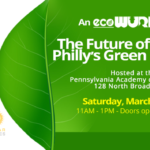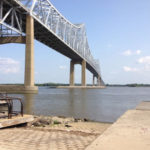We don’t know … and that’s a problem
by Malcolm Burnley | ecoWURD Contributor
Air pollution, like practically everything else in the United States, is a phenomenon tinged by racial segregation. And Philadelphia — boasting an “F” grade for air quality from the American Lung Association, along with persistent racial and class segregation — would be no exception to these trends, which have real world implications for public health. However, in Philadelphia, like a lot of places in the country, there’s little infrastructure or baseline data in place for tracking how air toxins affect neighborhoods at varying levels throughout the city.
BAD AIR QUALITY IS A VERY BLACK PROBLEM
“African Americans are exposed to 38 percent more polluted air than Caucasian Americans, and they are 75 percent more likely to live in fence-line communities than the average American,” wrote the authors of a highly touted 2017 report co-authored by the NAACP and the Clean Air Task Force, titled Fumes Across the Fence-line.
Fenceline communities — a perennial subject of discussion among federal monitors at the Environmental Protection Agency — are places adversely impacted by industrial or service facilities (such as oil and gas plants, power plants, and hazardous waste facilities) due to their proximity to known emissions. They’re also vulnerable to leaks or other fugitive chemical toxins that are likely to go unnoticed. African-Americans and Latinos are overrepresented in fenceline communities. “Most fence-line communities in the United States are low-income individuals and communities of color who experience systemic oppression such as environmental racism,” the NAACP co-authored report reads.
In Philly, that would characterize those populations living adjacent to the Philadelphia Energy Solutions refinery in Southwest, the Philadelphia Gas Works plant in Port Richmond, or, perhaps, in the near future, SEPTA’s proposed natural gas plant in Nicetown.
Yet comparing these neighborhoods — against each other or to others— and the unique air quality concerns within them is more of a fraught task than you might imagine. Despite the fact that Pennsylvanians have a civil right to clean air via the state constitution, there’s little evidence outside of a regional air quality data to judge whether this right is being protecting at the level of a zip code, ward, or residential block.
“The Clean Air Act is structured in a way that you look at regional air quality, meaning that the communities worst-off aren’t being represented in the way that is being collected in the data,” says Dr. Gwen Ottinger, director of the Fair Tech Collaborative, a social justice organization, and a professor at Drexel University. “And that’s a strategic choice. They weren’t thinking about it on a community level.”
PHILLY’S AIR MANAGEMENT SYSTEM FALLS SHORT
Inside the Philadelphia Department of Public Health, the Air Management Services (AMS) is the closest thing we have to a local air pollution control agency. It’s tasked with monitoring federal air quality standards as outlined by the federal Clean Air Act by taking regular samples from 11 sites across the city.
It just so happens that those citywide samples from AMS are overwhelmingly located in zip codes where the White population of the city has been growing. Conversely, areas with historically low White populations have a smaller share of those monitors. For example, there are monitors in Brewerytown, Roxborough, Northern Liberties, Society Hill and Graduate Hospital. There are no monitors in North Philadelphia, Kensington, or Port Richmond. (The primary exceptions to this are two monitors in Point Breeze and Grays Ferry, which exist for tracking the industrial outputs of the PES refinery, the airport, and the Navy Shipyard.)
The racial disparity might be a coincidence, having less to do with local decision-makers and everything to do with the federal mandate of the Clean Air Act. The official response from the City on the distribution of AMS monitors throughout the city hued closely to this idea, citing strict federal guidelines for where its monitors are placed. .
“Factors in establishing such monitoring sites include, but are not limited to, population density, proximity to significant sources of air pollution, and presence of obstructions,” said James Garrow, director of communications for the Philadelphia Department of Public Health, in a written statement.
The lopsided distribution is a consequence of these federal priorities. “Industrial facilities considered major sources of air emissions in the City are clustered in the southwest (ex: Airport, Philadelphia Refinery, Philadelphia Shipyard), or along the I-95 corridor (ex: AdvanSix Phenol Plant, Kinder Morgan Liquids Terminal) parts of Philadelphia.”
Besides, Garrow adds, Philadelphia gets a greater number of the state’s air-monitoring resources than one would expect. “In terms of numbers, Philadelphia occupies ~ 0.3% of the land in Pennsylvania but otherwise contains ~10% of the federally required air monitoring sites in the state,” he writes.
It’s also true that we may know more information soon. As of May 2018, the city has deployed 50 new air monitors — including a number in North Philadelphia — towards a new initiative called the Philadelphia Air Quality Survey. Garrow explains this new survey is designed to track some of the neighborhood-specific air quality data that’s proven elusive. Although the first set of data won’t be made public until late 2019 at the earliest.
“It’s not that anyone is failing to do their job,” says Dr. Ottinger. “it’s that we’ve set up the system in a way that it’s nobody’s job to do.”
READING BETWEEN THE LINES
There’s a growing body of medical research that suggests the dirty air we breathe gets directly passed on to our sons and daughters in problematic ways, whether cities are tracking it or not..
In September, a scientific paper out of Europe sparked headlines by presenting, for the first time, documentation of carbon-pollution participles found in everyday fossil fuels within the placentas of non-smoking mothers. The implications seemed troubling: analysts suggested that fossil fuels are likely reaching the bloodstream of newborns in vitro. Such research compounded existing evidence of air pollution – including that exposed to mothers – as a contributing factor in early-childhood health outcomes.
Outside of case studies, however, conclusions about the air we breathe as it relates to broader public health concerns remains speculative. We know that Philly has high infant mortality rates compared to other big cities, and a growing maternal mortality crisis, but what role, if any, pollution from air toxins plays is a mystery.
“We have anecdotal stories of mothers dying shortly after child birth or a child with asthma. But if we don’t have the data, we can’t really come up with the solutions,” says State Representative Donna Bullock, who sits on the Environmental Resources and Energy Committee in Harrisburg.
AN OLD PATTERN OF MONITORING NEGLECT
For some, the historic failure to assess health risks in African American areas fits an old pattern.
“Racism, discrimination and years of oppression have shaped the institutions that are responsible for providing care and providing resources in the city,” says Bullock. “All these issues are shaped by the ugly forces of racism and discrimination.”
It’s bad enough when recent studies show a correlation between bad air quality and a noticeable reduction in verbal and math test scores, according to a survey from the National Academy of Sciences released last year. But potentially worse when interactive Philly-specific trackers published by the EPA in recent years fail to account for data on any granular level. There’s little more to offer from the state government. Neither the Office of Environmental Justice nor the Office of Health Equity (both within the PA Department of Health) could point ecoWURD to data on the health disparities stemming from air pollution in Philadelphia, either along racial lines or drawn by neighborhood boundaries.
Still, in a May 2018 Bloomberg report, Garrow seemed optimistic about the city’s overall ability to mitigate high air pollution levels.
That was after the EPA discovered Philadelphia (between 2014 to 2016) had a staggering 77 parts per billion of air pollution concentration – 7 points above the EPA’s own recommended target for such. When the agency ordered Philadelphia to meet those goals by 2021, Garrow simply responded: “We feel that our current activities have put us on track to meet that level by the three-year deadline.”
Yet, we know that environmental pollutants in Philadelphia are disproportionately hurting African American families in the aggregate nonetheless. That was recently bolstered by a study compiled by a team of medical researchers from Drexel and the University of Pennsylvania, which looked at the “place-based stressors associated with industry and air pollution” using focus groups of Philadelphia residents. Researchers found that living in a polluted neighborhood adds a level of toxic stress that carries potentially severe health implications, irrespective of the respiratory concerns that are threatened by inhaling these particles. There’s a damaging psycho-social aspect to living in a polluted place, which, we know from the other studies referenced above, that affects African Americans more than others.
“These stressors can influence health by triggering negative emotions (such as fear, anxiety or depression), which affect physiological processes such as endocrine and immune systems and increase risk of disease,” the researchers found from interviews with the focus group of residents in high-pollution parts of Philly. “Social stressors have been shown to affect respiratory disease, asthma, cardiovascular disease, cancer, depression, and HIV/AIDS.”
It’s not known how much of a role air pollution plays in the well-documented health disparities in Philadelphia, although it’s safe to assume it exists. When a team of experts analyzed the troublingly high maternal mortality rate in Philadelphia in a 2015 report (new mothers in Philadelphia passed away at a rate that was 53 percent higher than the national average between 2010 and 2012) published by the 30-member Philadelphia Maternal Mortality Review, they found a negligible percentage of deaths were attributed to medical mismanagement. Instead, broader social factors led to these outcomes. In many ways, it was a precursor to a national investigation by the New York Times last year into maternal mortality among African American moms in the U.S., which suggested stress from discrimination — and other factors unique to Black mothers — was a leading factor in the disparity.
“Women who come to pregnancy with more stress make the pregnancy more difficult,” says Marianne Fray, executive director of the Maternity Care Coalition. “ Something that our advocates will do is identify any lead that might be present in the homes, because we are trying to improve the safety of mom and baby. If we identify lead, we can provide resources. But that doesn’t mean other environmental factors couldn’t be impacting the families as well.”
Environmental stressors like air pollution, and the internalization of living on a trash-strewn block, studies suggest, might very well fall into that same bucket. Whoever is to blame, the air quality outlook for many of the most densely populated Black neighborhoods in Philly remains, to a degree, a crisis lacking definition and needed attention.



